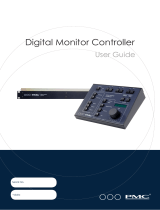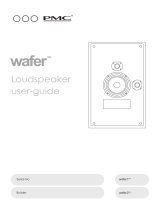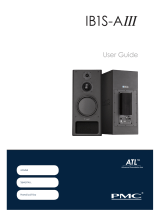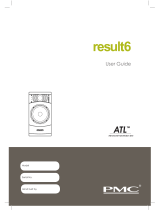Page is loading ...

reference monitoring all ways
User Guide
Model
Serial No.
Hand built by
TM
Advanced Transmission Line


IMPORTANT
!
Warranty Certicate
Please take a few moments to complete the warranty card at the back of this
booklet (or register at www.pmc-speakers.com) as this not only records the
purchase of your loudspeakers, but also provides you with an opportunity to make
suggestions and provide feedback directly to PMC.
Product Support
For product support, accessories or servicing advice, please contact
a PMC authorised dealer/distributor. See www.pmc-speakers.com and click on
‘Where to buy’.
Company Details
THE PROFESSIONAL MONITOR COMPANY LIMITED
HOLME COURT, BIGGLESWADE, SG18 9ST, UK
T +44 (0) 1767 686300
[email protected] www.pmc-speakers.com
© 2019 PMC. All rights reserved.
PMC stock code: 14594 . Ref. no - 317 v6
This document should not be construed as a commitment on the part of PMC. The information it contains is
subject to change without notice. PMC assumes no responsibility for any errors within this document.
CE Conformity: PMC active loudspeakers conform to EC Directive LVD2006/95/EC and EMC 2004/108/EC.
WEEE European directive: PMC is a member of a National Compliance scheme and has gained the
associated certication of compliance from the Environment Agency with the registration WEEE/GJ0101WU.
WEEE EU Directive
This symbol on the product, and in or on its packaging, indicates that this product must not be disposed
of with other household waste. It is the responsibility of the owner to dispose of waste equipment via a
designated collection point for the recycling of waste electrical and electronic equipment. The recycling
of waste equipment is an attempt to conserve natural resources and ensures that it is recycled in a manner
that protects human health and the environment. For more information about where to dispose of waste
equipment for recycling, please contact your local waste/recycling authority or the dealer from whom you
purchased the product.

A message from Peter & Oliver Thomas
Our sole aim while designing loudspeakers is to recreate the true essence of an artist’s
intention, combining the ultimate level of sonic resolution with solid engineering principles.
We believe that the same loudspeaker can be used throughout the entire audio chain,
from composer to studio or lm stage, post-production or mastering and then, nally, the
consumer. We also think that a well designed loudspeaker should be able to excel regardless
of the audio genre, and reproduce spoken word, rock, pop, or classical music with the
same precision and accuracy. Our unswerving passion for getting it right has made this goal
possible.
Thank you for choosing PMC products. Please read this user guide and install your new twotwo
series monitors bearing in mind the advice given within.
Peter Thomas Owner
Oliver Thomas Head Of Design

PMC: the authority for quality sound.
Congratulations - You have joined the elite.
Over more than two decades PMC has
earned an unrivalled reputation for creating
the world’s nest professional loudspeakers.
Simply put, our loudspeakers provide
a reference for the very highest prole
productions and events. They are found at
every stage of the creative process, from
conception to recording and broadcast
and, of course, in the home.
Our client list reads like a who’s who of
the sonically aware, with Stevie Wonder,
Elbow, Coldplay, Brian May, Universal, EMI,
Sony, Capitol Studios, Pinewood Studios,
Dreamworks, Metropolis Studios and the BBC
among the makers of movies and music who
use our products.
Our loudspeakers were also used in
the production of Titanic, The Bourne
Supremacy, Game of Thrones, Skyfall,
Finding Dory, the Pirates of the Caribbean
franchise, and during broadcasts of the
London Olympics, 2012.
EMI
Stevie Wonder
BBC
Tony Bennett
Coldplay
UNIVERSAL MUSIC GROUP
elbow
Thomas Newman
Afrojack
Warner Music
Kraftwerk
Pinewood Studios
Capitol Studios
Google
ESPN
SONY
JVC Studios
Metropolis Studios

User guide
Contents
General usage guidelines
Introduction
Unpacking and care
PMC’s
TM
Advanced Transmission Line
– How the Advanced Transmission Line works
System description
User EQ options
Connections
Running in
Applications and accessories
Positioning
Surround system set-up
Specications
Operational controls
Notes
Service
The PMC range
The Matching active twotwo subs
Our meticulous care and attention
Inspection certicate
Warranty online
Warranty certicate – Part 1 – Your copy
Warranty certicate – Part 2 – PMC’s copy
Your Comments – Help us improve

Important safety instructions
Read these instructions.
Keep these instructions.
Heed all instructions.
Follow all instructions.
Do not use this apparatus near water.
Clean only with dry cloth.
Do not use solvents, abrasives, waxes or liquids as they may be detrimental to the nish.
Do not block any ventilation openings. Install in accordance with the manufacturer’s
instructions.
Do not install near any heat sources such as radiators, heat registers, stoves, or other
apparatus (including ampliers) that produce heat.
Do not defeat the safety purpose of the polarized or grounding-type plug. A polarized plug
has two blades with one wider than the other. A grounding type plug has two blades and
a third grounding prong. The wide blade or the third prong are provided for your safety.
If the provided plug does not t into your outlet, consult an electrician for replacement of
the obsolete outlet.
Protect the power cord from being walked on or pinched particularly at plugs, convenience
receptacles, and the point where they exit from the apparatus.
Only use attachments/ accessories specied by the manufacturer.
Use only with the cart, stand, tripod, bracket, or table specied by the manufacturer, or
sold with the apparatus. When a cart is used, caution when moving the cart/apparatus
combination to avoid injury from tip-over.
Unplug this apparatus during lightening storms or when unused for long periods of time.
Refer all servicing to qualied service personnel. Servicing is required when the apparatus
has been damaged in any way, such as power-supply cord or plug is damaged, liquid has
been spilled or objects have fallen into the apparatus, the apparatus has been exposed to
rain or moisture, does not operate normally, or has been dropped.
Packaging material can pose danger to the young and vulnerable. Ensure these items are
stored or disposed of safely.
The twotwo series monitor loudspeaker can produce high sound pressure levels. Exposure to
high levels of sound has the potential to cause hearing damage. Use care when adjusting
the system volume to ensure sound pressure levels remain within safe and comfortable
limits.
Very powerful magnets are employed in the twotwo series which may have a detrimental
effect on magnetically-sensitive items if placed too close, such as CRT (tube-style)
televisions or monitors, and media such as cassettes and videotapes.
PMC has made efforts to provide accurate installation information and good quality
xings. However, PMC will not be held responsible or liable for injuries or property damage
(direct, indirect or consequential) arising out of use or inability to use this product safely
and properly.

Thank you for choosing PMC twotwo series active reference loudspeakers. This guide provides
installation and operating instructions for the twotwo.5, twotwo.6 and twotwo.8 monitors, which
have been specically designed to enable use in either vertical or horizontal orientations without
compromising the stereo imaging or tonal accuracy.
These monitors build upon PMC’s world-class design pedigree, combining the nest drivers
available with the unique
TM
Advanced Transmission Line
(Advanced Transmission Line) bass loading principle, sophisticated
Class-D amplication and ultra-precise DSP control.
PMC’s unique
TM
Advanced Transmission Line
technology uses contemporary materials to provide optimised absorption of
unwanted midrange energy within the cabinet, while extending bass output signicantly with
negligible harmonic distortion. Please note that the twotwo cabinets are handed, meaning that
the tweeter is offset to one side of the bass driver. In normal use the monitors should be arranged
with the tweeters on the inside edge nearest the listening position.
The drivers employed in the twotwo monitors are bespoke PMC designs using natural materials.
The newly developed 27mm precision soft-dome tweeter delivers ultra-high resolution and a
neutral balance. Its perforated acoustic lens extends the response beyond 20kHz and controls
dispersion to ensure perfect integration through the crossover region. The bass driver uses an
ultra-light and ultra-stiff doped-paper cone to deliver unparalleled transient response and
untainted mid-range.
The electronics built into each cabinet provide two channels of ultra-low distortion Class-D power
amplication, with a DSP-based crossover providing perfect driver optimisation and integration.
A non-aggressive protection system based on modelled excursion limiting is also implemented in
the DSP, and the twotwo badge changes colour to red when the protection system is working.
Balanced and unbalanced analogue, and AES3 digital inputs are accepted.
‘PMC’s twotwo series is designed and hand-built in Britain, by nice people who care and who love audio’
Introduction

Unpacking and care
PMC twotwo series active monitors are packed in heavy-duty protective cartons. Please retain these to
ensure that the loudspeakers can be transported safely if the need arises in the future. If you dispose of
the packaging please do so in an environmentally responsible and safe way.
What’s in the Box?
twotwo series monitors are heavy. Please take care when lifting them from the cartons, being
particularly careful not to touch the tweeter dispersion grilles. Do not attempt to use these
speakers if the packaging has been water-damaged.
Care and Service
In normal usage PMC speakers should provide many years of trouble-free operation, but in the unlikely
event that you suspect damage or failure has occurred do not attempt to repair the unit yourself.
There are no user-serviceable parts inside. Contact your dealer for advice and a service return address.
Clean the cabinets only with a dry and lint-free cloth, and avoid the use of solvents as they may
damage the nish of the unit.
!
1x twotwo.5, twotwo.6 or twotwo.8 monitor
1x AC mains power cable
1x RJ45 control link cable
1x User Guide
Please Note: This unit must be earthed.
!

A further advantage of the ATL design
approach is greater bass extension and
higher SPL capability compared to typical
ported or sealed designs of a similar size –
even if similar drivers were used.
Moreover, the very consistent bass driver
loading brings the welcome benet that
the frequency response remains consistent
regardless of listening level, and analytical
auditioning can be conducted without
needing high replay volumes just to achieve
an optimal bass response. This is a unique
and very valuable characteristic of PMC’s
Advanced Transmission Line.
PMC’s unique TM
Advanced Transmission Line
(Advanced Transmission
Line) enclosures have taken loudspeaker
design to the highest level, using sophisticated
cabinet construction, proprietary drive units,
and patented absorption materials and
techniques. The benets are enormous
compared to the relatively simple sealed and
ported designs currently available elsewhere.
PMC’s innovative approach places the bass
driver near one end of a long cavity (the
Advanced Transmission Line). This cavity
is heavily damped with acoustic material
specied carefully to absorb the upper bass
and higher frequencies radiating from the rear
of the bass driver. The lowest frequencies are
allowed to pass down the line and emerge
from the large frontal vent in the same polarity
as the driver’s direct radiation, the vent acting
essentially as a second bass driver.
An important benet of the TM
Advanced Transmission Line
approach is
that the air pressure inside the cabinet, which
loads the bass driver, remains consistent.
This helps to maintain control of the driver
over a wide frequency range and signicantly
reduces LF distortion. Consequently, the upper
bass and midrange detail is not masked by
harmonic distortion and the result is PMC’s
characteristically transparent midrange, fast,
attacking bass, and outstanding clarity.
Advanced Transmission Line
How it works TM
Advanced Transmission Line
‘No other bass loading technology provides such resolution and tonal accuracy at all volume levels’

System description
The electronic heart of the twotwo series
active monitor is a powerful DSP engine
which operates at a xed sample rate of
96kHz.
Balanced and unbalanced analogue inputs
are conditioned by a low-noise gain stage
prior to A-D conversion, to optimise the
signal-noise ratio. The converter is a very
high quality delta-sigma device, producing
a 24-bit, 96kHz output. The AES3 digital input
can accept sample rates up to 192kHz
and is sample rate converted to 96kHz
automatically.
The DSP engine provides the overall system
volume control, 24dB/octave precision
crossovers, driver optimisation, and driver
protection. This sophisticated digital signal
processing ensures perfect matching between
the two drivers’ responses and roll-off rates,
optimising the contribution of each driver,
minimising distortion, and providing a atter and
more natural balance over the widest possible
listening area.
The DSP system outputs are converted back to
analogue to feed two separate Class-D power
ampliers and their respective drivers.
A total of 200W of high-efciency amplication
is provided, with 50W for the tweeter and
150W for the bass unit. The amplier design
ensures that driver impedance variations with
frequency are fully compensated to maintain
a uniform frequency response.
Analogue
input
Gain
stage A/D DSP DAC
SRC
Digital
input
HF AMP
LF AMP
Volume, EQ,
crossover and
protection
XLR or RCA/
phono
Adust level
to utilise full
scale of A/D
24-bit
converison
Conversion to
analogue for
amplification Individual
power amps
for HF and LF
drivers
Sample rate
conversion
AES3 XLR
32-192kHz

User EQ options
PMC’s twotwo series active monitors feature DSP-based user-equalisation options. These comprise
separate low frequency (LF) and high frequency (HF) shelving responses, plus low frequency
slope options. The HF and LF shelving equalisers are
each adjustable over a range of ±4dB in increments
of 0.125dB. The HF shelving frequency is 1kHz for
both the twotwo.5, twotwo.6 and twotwo.8 models,
and adjustment of the HF level can be useful in
counteracting the effects of the room’s acoustics
and local reections.
twotwo.5 - 750Hz
twotwo.6 - 500Hz
twotwo.8 - 500Hz
The LF shelving is different for each model
because of their differently sized cabinets.
For the twotwo.5 model the bass shelving
frequency is 750Hz, while it is 500Hz for the
larger twotwo.6 and twotwo.8 models.
The ability to adjust the low frequency level and roll off enables compensation for the effects of
room boundaries, since if a monitor is placed close to a wall or corner the perceived quantity of
low frequency energy will increase, often quite dramatically and with a detrimental effect on the
overall accuracy of audio reproduction.
The LF slope adjustment provides a 6dB/octave high-pass
lter to further assist in compensating for placement close to
room boundaries.
Please see page16 for further information on optimising the
positioning of twotwo series monitors.

Connections
!
Caution
To avoid potential damage, please ensure that the signal source is turned off before
connecting or disconnecting your active twotwo series loudspeakers.
Connections
The rear panel of the twotwo series monitor loudspeaker carries various connectors for
audio, control and mains power.
Audio
The electronically-balanced analogue input and the AES3 digital
input accept 3-pin male XLR connectors, wired with Pin-1 screen
(ground), Pin-2 signal positive (hot), and Pin-3 signal negative
(cold). An RCA-phono socket is provided to accept unbalanced
analogue signal source. The appropriate input is selected via the
rear panel menu system.
Power
The IEC (C14) mains socket is provided with adjacent power
switch. There is no AC voltage selector; the twotwo series monitor
can accept any AC mains voltage between 90-132 and 180-264V.
THIS UNIT MUST BE EARTHED
In – Thru Connections
The ‘IN’ RJ45 socket accepts volume data and digital audio from the previous twotwo
speaker in the chain (the rst in the chain acts as the Master Volume controller). An
optional Remote Control unit can also be connected to the IN socket.
The ‘THRU’ socket sends the control signal to the next speaker, and also passes the
digital audio signal if the rst speaker has a valid digital input from either its AES3 or
RJ45 ‘IN’ connectors. Note: if the AES3 XLR and RJ45 ‘IN’ are both receiving valid digital
audio, the XLR input automatically takes priority.
The twotwo badge on the front panel changes colour from white to red if the excursion
limiting protection system is activated. If this happens reduce the input level.
!

Running-in
When brand new, PMC loudspeakers will take a short period of use before they
reach their full potential.
This is because the mechanical and acoustical characteristics of the bass
driver and tweeter alter slightly after manufacture as the exible elements in
their construction relax and reach their optimum compliancy. The cabinet
parameters are critically designed to load the bass driver accurately only when
it has reached its long-term, optimal compliancy.
Consequently, during the initial running-in period of about 50 hours, the
performance of the twotwo series active monitor will change and improve. You
will notice the bass tonality becoming fuller, more accurate and neutral, and
the bass extension will increase signicantly. As the tweeter relaxes the treble
tonality also sweetens and integrates perfectly with the bass unit, and the sound
staging improves.
TM
50+ hours to run-in
1122
111
1100
99
88
77 66 55
44
33
22
11
1

Applications and accessories
Applications
The ultra-high resolution response of twotwo series makes them ideal for any critical evaluation
of audio. Typically, twotwo series monitors are used for near-eld monitoring of music, speech
recording and mixing, in OB vehicles, radio on-air studios and TV sound control galleries, home
theatre, high-end hi-, project studios, post-production, editing suites, music mastering, and for
A&R evaluations.
Accessories
It is ideal if monitors are positioned with the tweeter close to
ear height, and kept stable during operation. The structure
and materials used to support the monitor will have a
bearing on how it performs. PMC offers purpose-designed
high mass ‘tube104 stands’, with the option of the fully
adjustable twotwo stand top plates that allow for an ideal
support for the larger twotwo.6 and twotwo.8 monitors in
either vertically or horizontal positions. Dedicated wall
brackets are also available to support the twotwo.5 and
twotwo.6 monitors.

Positioning
With their unique TM
Advanced Transmission Line
cabinet design, wide dispersion, ultra-low distortion, and smooth bass
roll-off, PMC loudspeakers are more forgiving of difcult room conditions and placement
constraints than conventional designs – you will be able to achieve a superb sound throughout
the room with little effort. However, we encourage you to spend some time experimenting in
your own room to achieve the very best results, remembering that small changes in location can
often inuence system performance signicantly. The following guidelines are suggestions for a
starting point to locate your new loudspeakers. Fine-tuning of their positioning can start
from there.
Dispersion and Toeing-in
Most loudspeakers have a relatively narrow dispersion and are designed to be aimed directly
at the listening position, as shown in the left-hand image below. However, the excellent stereo
imaging which PMC monitors are known for is due, in part, to their wide dispersion characteristic,
as shown on the right-hand image. To optimise the stereo imaging, PMC monitors should be
angled so that their axes cross about 0.5 metres (2ft) behind the listening position (as illustrated
below). Varying the ‘toe-in’ angle to adjust the actual point at which the speaker axes crossover
will subtly affect the vividness of the audio soundstage.
Conventional monitors
have narrow dispersion
which restricts the width of
the accurate listening area
PMC Monitors have wide
dispersion to provide accurate
sound across the widest
possible listening area

TIP
TIP
When initially positioning the loudspeakers, ideally they should be located at two of the three
points of an equilateral triangle, with the listener at the third. If the monitors are spaced too far
apart the stereo image will be wide but central denition will be impaired. Use a well recorded
vocal track to judge the ideal placement.
Attention should be paid to the effect of reective surfaces such as side walls and objects in
close proximity to the loudspeakers, such as computer screens. Excessive neareld reections
from these kinds of objects will blur the stereo imaging signicantly, and may introduce
unwelcome colouration of the sound.
Place the speakers so that their front bafes are well forward of any objects placed between
them, such as computer display screens.
With regard to optimising the speaker height, the acoustic axis of all twotwo cabinets is midway
between the HF and LF drivers. This axis should be level with the listener’s ears.
To prevent vertical room modes from causing boominess, do not position the speaker such that
the bass driver is at an even proportion of the room height, such as a half or a quarter.
Speaker Orientation
twotwo series monitors are designed to be used either in upright
(portrait) or horizontal (landscape) orientations without affecting
the tonal or stereo imaging performance. This also allows their
use as a low prole centre channel in surrounded systems. For
this reason, twotwo series monitors are ‘handed’, and in normal
applications the tweeters should be placed on the ‘inside’ of the
listening triangle, as these illustrations demonstrate.
left
left
right
right

Positioning (cont.)
TIP Ideally, the monitors should be placed more than 0.5 metres from the side and rear walls of
the room so that reinforcement and cancellation (peaks and dips) of the bass output caused
by wall reections will be moved higher in frequency and thus less inuential. This reduces the
incidence of ‘lumpy’ or ‘boomy’ bass. Small changes in position can have profound effects on
the bass response, so experiment to nd the optimal position.
Bass Response
twotwo series active monitors can produce signicant bass energy below the frequencies at
which they become omnidirectional. As a consequence, it is important to consider the effect of
the boundaries of the listening room when placing the monitors.

5.1 Systems
The twotwo series has been designed for perfect
multi-channel music or movie playback. The following
diagrams indicate the ideal speaker layouts.
The constraints of room size and shape will often force
some loudspeakers to be placed closer or further from
the listening position than is ideal. In such situations the
time-alignment facilities of the surround processor or
monitor controller should be employed to compensate.
When bass management is being used the subwoofer
carries not only the LFE signal, but also the low bass from
some, or all, of the main monitors as well. The subwoofer
should be placed at the front of the room, and the optimal
position provides the smoothest low bass without boomy or
weak notes.
7.1 Systems
In a system capable of 7.1 Dolby® Digital Surround
EX™, DTS® ES™ or Blu-ray™ playback there will be two
sets of surround speakers. The rst pair (surround or
side channels) should be positioned at 100º, and the
second set (rear or back channels) at 150º. (The front
centre axis is 0º while directly to the rear of the room
is 180º).
Surround sound systems
TIP
TIP
Dolby® Digital Surround EX™ is a registered trademark of Dolby® Laboratories. DTS® ES™ are
registered trademarks of DTS® Inc. Blu-ray™ is a trademark of the Blu-ray™ Disc Association.

Specications*
* Specications subject to change
Shared specications
Input Connectors Balanced analogue XLR, unbalanced RCA/phono
AES3 digital XLR, (left/right channel selectable)
All XLR-3F connectors wired Pin-1 screen, Pin-2 hot, Pin-3 cold
Each input has independent ±8dB trim range
Input Sensitivity Adjustable +4 to +15dBu
Digital Sample Rate 32 -192kHz, 24-bit via internal sample rate converter
Mains Power IEC connector. 90-132 / 180-264V AC auto-sensing.
Amplier Section LF 150Wrms, HF 50Wrms
User Equalisation LF Shelf ±4dB at 750Hz (twotwo.5), 500Hz (twotwo.6) & 500Hz (twotwo.8)
HF Shelf ±4dB at 1kHz
LF Rolloff 6dB/octave (50, 80, 120, 150, or 200Hz)
Volume Range -48.5dB to +15dB
Usable frequency response
Maximum SPL
Effective
TM
Advanced Transmission Line
length
Crossover frequency
Drive units
Cabinet dimensions
Weight
35Hz - 25kHz
115dB @1metre
1.9m (6.2ft)
1.8kHz
LF 200mm (8.0 inch)
HF 27mm Soft Dome
H 500 W 250 D 415 (mm)
12.2kg
40Hz - 25kHz
113dB @1metre
1.6m (5.25ft)
1.8kHz
LF 170mm (6.5 inch)
HF 27mm Soft Dome
H 406 W 194 D 364 (mm)
8.4kg
50Hz - 25kHz
111dB @1metre
1.5m (4.92ft)
1.8kHz
LF 140mm (5.5 inch)
HF 27mm Soft Dome
H 296 W 155 D 295 (mm)
5.4kg
/











